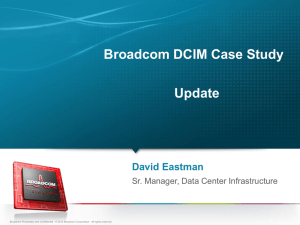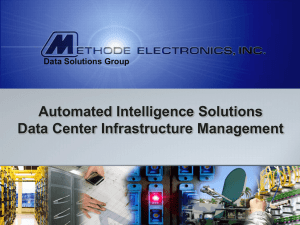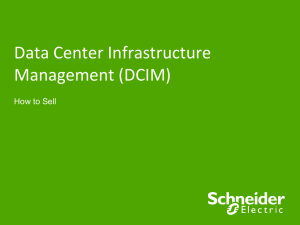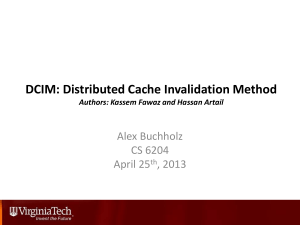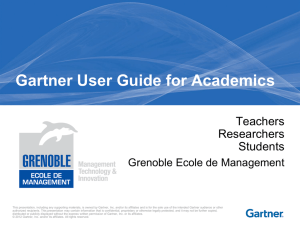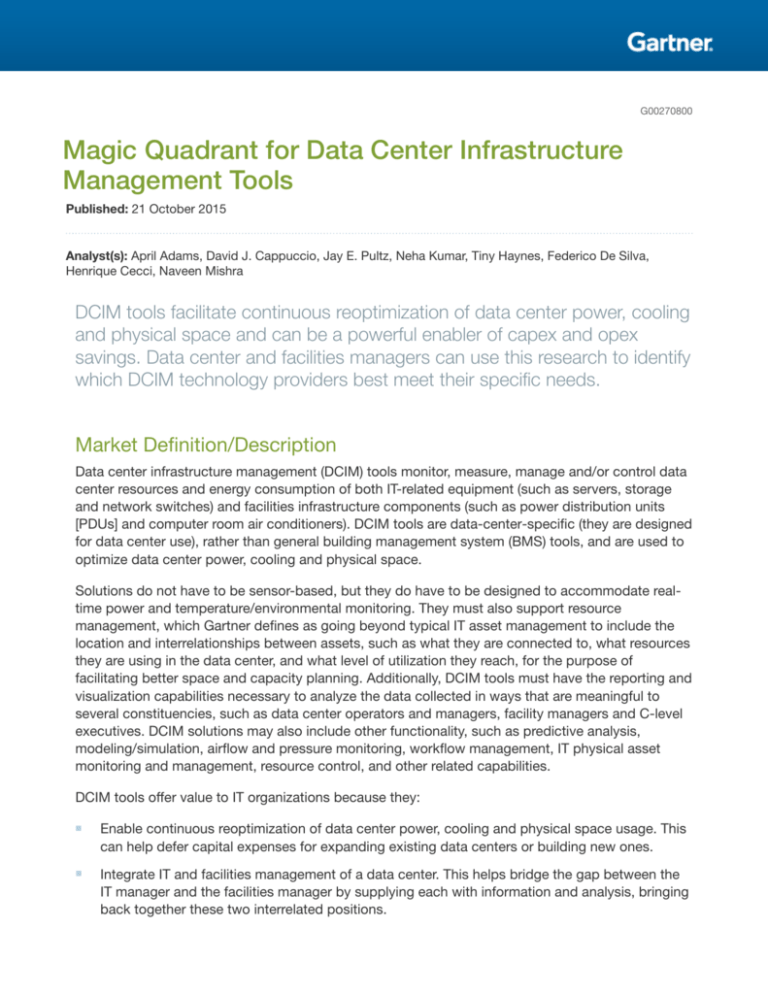
G00270800
Magic Quadrant for Data Center Infrastructure
Management Tools
Published: 21 October 2015
Analyst(s): April Adams, David J. Cappuccio, Jay E. Pultz, Neha Kumar, Tiny Haynes, Federico De Silva,
Henrique Cecci, Naveen Mishra
DCIM tools facilitate continuous reoptimization of data center power, cooling
and physical space and can be a powerful enabler of capex and opex
savings. Data center and facilities managers can use this research to identify
which DCIM technology providers best meet their specific needs.
Market Definition/Description
Data center infrastructure management (DCIM) tools monitor, measure, manage and/or control data
center resources and energy consumption of both IT-related equipment (such as servers, storage
and network switches) and facilities infrastructure components (such as power distribution units
[PDUs] and computer room air conditioners). DCIM tools are data-center-specific (they are designed
for data center use), rather than general building management system (BMS) tools, and are used to
optimize data center power, cooling and physical space.
Solutions do not have to be sensor-based, but they do have to be designed to accommodate realtime power and temperature/environmental monitoring. They must also support resource
management, which Gartner defines as going beyond typical IT asset management to include the
location and interrelationships between assets, such as what they are connected to, what resources
they are using in the data center, and what level of utilization they reach, for the purpose of
facilitating better space and capacity planning. Additionally, DCIM tools must have the reporting and
visualization capabilities necessary to analyze the data collected in ways that are meaningful to
several constituencies, such as data center operators and managers, facility managers and C-level
executives. DCIM solutions may also include other functionality, such as predictive analysis,
modeling/simulation, airflow and pressure monitoring, workflow management, IT physical asset
monitoring and management, resource control, and other related capabilities.
DCIM tools offer value to IT organizations because they:
■
Enable continuous reoptimization of data center power, cooling and physical space usage. This
can help defer capital expenses for expanding existing data centers or building new ones.
■
Integrate IT and facilities management of a data center. This helps bridge the gap between the
IT manager and the facilities manager by supplying each with information and analysis, bringing
back together these two interrelated positions.
■
Enable achievement of greater energy efficiency. Energy cost savings alone are often enough to
make a business case for justifying the purchase of DCIM tools, although these tools offer other
benefits that are more difficult to quantify, such as improved workflow.
■
Model and/or simulate the data center, enabling the IT manager and the facilities manager to
assess "what if" scenarios.
■
Enhance resource and asset management by showing how the resources/assets are
interrelated.
These benefits of DCIM are better-understood than they were a year ago, and as a result, there has
been a gradual, overall increase in DCIM investments, although DCIM adoption patterns do vary by
organization size and geography. Large organizations tend to be the strongest candidates for DCIM
deployment, because of the way DCIM tools can positively impact resource utilization, data center
planning efforts and overall initiatives to save on capital expenditure (capex) and operating
expenditure (opex) in their larger data centers. North American and multinational companies
demonstrate the highest current and future demand for DCIM. Adoption of DCIM in Asia/Pacific,
driven by expansion in the number of data centers in the region, outpaces adoption in Western
Europe, which is still mired in economic hardships. Eastern Europe, the Middle East and Africa, and
Latin America remain relatively immature in terms of DCIM adoption, but where they do deploy, they
tend to opt for modular and lower-priced point solutions with the goal of addressing specific
challenges rather than rolling out a full DCIM suite to reap the broader benefits.
Price, ease of deployment, and overall ease of use continue to be some of the biggest concerns
customers have when selecting a DCIM vendor and product. They are also among the top reasons
why some organizations are choosing not to deploy DCIM (yet or at all). As a group, the vendors in
our evaluation are aware of these concerns and are taking steps to address them, albeit in different
ways and with varying degrees of success. Generally speaking, however, DCIM pricing has come
down significantly in the past three years and represents only a small percentage of the overall total
cost of ownership for the data center. Additionally, improving the initial implementation experience
and overall ease of use are "top of mind" for most vendors.
For more information on DCIM, see "Technology Overview for Data Center Infrastructure
Management Tools" or "Best Practices: Optimize Your Data Center Utilization With DCIM." For
further insight into the DCIM market dynamics, see "Market Trends: DCIM Product Managers Must
Fine-Tune Tactics for a Changing Market" and "Emerging Market Analysis: Targeting Your
Top DCIM Markets in Asia/Pacific and Latin America."
Page 2 of 21
Gartner, Inc. | G00270800
Magic Quadrant
Figure 1. Magic Quadrant for Data Center Infrastructure Management Tools
Source: Gartner (October 2015)
Gartner, Inc. | G00270800
Page 3 of 21
Vendor Strengths and Cautions
ABB
ABB is a $40 billion, publicly traded automation and power technology company headquartered in
Switzerland, with capabilities that extend from grid technologies to power distribution and industrial
process automation. Introduced in 2012, its DCIM solution (Decathlon for Data Centers) is facilitiesoriented; however, ABB partners with IT-oriented DCIM vendors and is now extending Decathlon for
Data Centers to cover the IT side, as well. ABB's focus is not mainstream DCIM, but rather to use
its industrial-grade process control technologies to extend DCIM to automate systems and
resources. ABB has primarily made inroads with this offering at large colocation and managed
hosting providers.
Strengths
■
ABB has a solid financial foundation to leverage as it continues to build its DCIM business.
■
Decathlon for Data Centers also applies to industrial sites and other locations. Its capabilities go
beyond DCIM to include mechanical and electrical system and process automation.
Cautions
■
ABB is transitioning operationally from a hardware-focused engineering company to a softwarefocused technology one. As a result, some of its operations are in flux, and its data center
initiative is fragmented across five business units.
■
Decathlon for Data Centers is principally marketed, sold and supported by a relatively small
team. ABB has yet to engage its strong partner network to sell DCIM.
CommScope (iTRACS)
CommScope is a publicly traded company with revenue of $5.3 billion (pro forma) after completion
of its recent acquisition of TE Connectivity's telecom, enterprise and wireless businesses. It is
based in the U.S. and participates in the DCIM market via its 2013 acquisition of iTRACS. Today,
iTRACS operates as a stand-alone business within the emerging solutions group in CommScope's
Enterprise business segment, where all of CommScope's data center solutions reside. The
company has recently begun a rebranding effort, dropping the former product name "Converged
Physical Infrastructure Management (CPIM)" in favor of simply iTRACS DCIM.
Strengths
■
iTRACS has a good understanding of how end users' DCIM product needs are evolving and a
solid product vision that positions it to address future market needs. Planned focus areas
include resource/asset management, multisite capabilities, and the integration of DCIM and IT
service management (ITSM).
Page 4 of 21
Gartner, Inc. | G00270800
■
iTRACS has strong 3D visualization and workflow capabilities today, with new functionality —
specifically in the areas of visualization and predictive analysis — under development.
Cautions
■
iTRACS DCIM is a feature-rich product, but those capabilities also create a complexity that
lengthens deployment cycles and causes a steep learning curve.
■
iTRACS' new flexible software-licensing-based pricing requires that customers start with asset
management and has no simple option for those interested only in power monitoring as a
starting point.
Cormant
Cormant is a U.S.-based pure-play DCIM vendor that has been delivering infrastructure
management tools since 2003. The Cormant-CS suite is configurable, allowing users to create any
data attributes required to provide a uniquely customized view of the enterprise IT infrastructure.
Cormant-CS uses configurability, network and environmental discovery, and historical data to
provide complete visibility of the infrastructure, allowing fast and accurate decisions when planning
or making change. Cormant-CS supports multiple locations from a single instance, providing a
global view of the enterprise. Current interfaces include ServiceNow, SDE, BMC Remedy, SAP
financials and HP Operations Manager.
Strengths
■
Cormant-CS is able to quickly document connections in the entire infrastructure, both power
and data, to ensure complete management.
■
Cormant-CS is portable, so it is applicable to all areas where IT is present, including data
centers, telecommunications rooms, work areas and campus environments, and ties into
workflow and process easily.
Cautions
■
The asset database and inventory system may conflict with or replace current configuration
management database (CMDB) or ITSM processes.
■
Integration with ITSM and workflow systems may be restrictive to some buyers.
Device42
Device42 is a privately held, U.S.-based company that was founded in 2011. It is a pure-play DCIM
vendor with a different business model than any other in the market. The Device42 software is
downloadable from the company's website, and customer support is provided either remotely (via
phone, email or an online portal), or via partners. Device42 software is licensed as an annual
subscription with pricing tiers based on the number of devices and IP addresses in use. It supports
power monitoring, power control and software license management as add-ons.
Gartner, Inc. | G00270800
Page 5 of 21
Strengths
■
Device42 stands out for the simplicity of its implementation and operation.
■
While Device42's software is used by large enterprises, its business model is particularly
appealing to smaller enterprises or those with fewer resources to dedicate to DCIM, since it
requires minimal operational support.
Cautions
■
Device42 provides the necessary DCIM functionality but at a more basic level natively than
most of its competitors. For example, polling intervals have a one-minute minimum unless the
user elects to utilize Device42-supported integrations with third-party applications, and it
currently cannot use historical trends to project future demand.
■
Device42 has a limited number of installation and implementation service partners globally for
when physical presence is required.
Emerson Network Power
U.S.-based and publicly traded, Emerson is a $24.5 billion global power, cooling and automation
system firm. Currently, Emerson Network Power is one of Emerson's five major business units and
focuses on critical infrastructure, including data centers and DCIM. In June 2015, Emerson
announced plans to spin off Emerson Network Power into a separate publicly traded company by
3Q16. Emerson entered the DCIM marketplace in 2009 when it acquired two DCIM pioneers,
Aperture and Avocent. Today, Emerson's flagship DCIM product is called Trellis, distinguished by
architecture that was designed from the ground up. Especially over the last year, Emerson has
improved Trellis' performance, implementation speed and user interfaces.
Strengths
■
Emerson has substantially restructured and enhanced its DCIM operation, including reshaping
its sales channel and enhancing user support.
■
Emerson now has a solid transition plan for customers of its older ("legacy") products that will
enable them to move to Trellis or a planned midtier platform, addressing an important prior gap
in its roadmap.
Cautions
■
Although scheduled for release by the end of October 2015, the midtier platform was not yet
generally available as of this publication and is therefore not yet market-tested.
■
Improvements in product performance and support have not yet translated to improved
customer satisfaction. Customers still report issues, especially with deployment speed and
effectiveness, and still report concerns about complexity.
Page 6 of 21
Gartner, Inc. | G00270800
FieldView Solutions
FieldView Solutions is a privately held, U.S.-based company that was founded as an independent
entity in 2009. It is a pure-play DCIM vendor that focuses on deployments in large data centers,
such as banks, colocation/hosting providers, e-commerce companies and government agencies.
FieldView's DCIM offering is made up of a core module (FieldView 2015) and optional additional
modules (PowerView, LiveView and DataView).
Strengths
■
The FieldView platform has some key desirable characteristics, such as being quick to install/
configure, scalability and native support to numerous protocols.
■
FieldView supports integrations with numerous BMS, CMDB, IT asset management (ITAM) and
ITSM solutions, many preintegrated right out of the box.
Cautions
■
FieldView focuses its sales and marketing efforts on the very high end of the market, targeting a
small cadre of large colocation/cloud providers and enterprises over 10 megawatts in size, or
companies with data centers ranging from 1 megawatt to 10 megawatts in multiple locations, a
strategy that could limit its future growth.
■
FieldView 2015 is primarily focused on power and environmental monitoring. Customers who
want additional DCIM capabilities must access them through FieldView's partnerships with
other DCIM players.
FNT
With its roots in the Germany, Austria and Switzerland (DACH) region, FNT is a founder-run business
with more than 20 years' experience in the data center management field. FNT has built on its
German marketplace and expanded out into the North American, Middle Eastern and Asia/Pacific
regions over the past few years. Its DCIM product, FNT Command, consists of four modules, all
based on FNT's data model, a repository that links information from the facilities side up the stack
to business processes. It is an open platform that is highly integrated and automated. Its DCIM
pricing structure is a concurrent user software license model, which is independent of data center
size.
Strengths
■
FNT is developing services specifically for the colocation market, building upon its multitenant
experiences with large-scale multinational data center deployments.
■
Using FNT Command in conjunction with FNT ServicePlanet provides a comprehensive and
integrated DCIM/ITSM capability.
Gartner, Inc. | G00270800
Page 7 of 21
Cautions
■
FNT's DCIM solution is principally geared to data monitoring, collection and workflow, with only
basic trending and analytics. As such, it will appeal primarily to data center operations staff.
■
Although FNT has made efforts to expand outside its dominant market of Germany, Austria and
Switzerland, it still does not have a significant footprint in major markets such as North America
and Asia/Pacific.
Geist
Geist is a privately held, U.S.-based supplier of power, cooling and environmental monitoring
equipment. It is owned by PCE, a large global manufacturer of plastic products and data center
solutions. Geist entered the DCIM market in 2007 with a product called Environet, which focused on
monitoring and management of power, cooling, security, environmentals, fire and life safety. In 2015,
Geist supplemented these capabilities with a new offering called Environet Asset and renamed its
original product to Environet Facility to better reflect its focus. The two modules are sold separately
but can be operated together with the addition of a connector. A companion product, Racknet,
which monitors power strips and environmental sensors for visibility of data center facility white
space, is also available.
Strengths
■
Environet Asset, which provides IT-side asset management, was purpose-built for Geist in 2015
to close one of the company's previous functionality gaps.
■
Geist has a large channel partner network that provides entrée into all major markets.
Cautions
■
Environet Facility and Racknet are licensed based on the number of integrated devices, which
users find complicated. Environet Asset uses rack-based pricing, which is more popular with
users.
■
Although Geist has a good understanding of overall market needs, planned additions to
Environet's functionality will put it on par with, but not ahead of, the competition.
Modius
Modius is a U.S.-based provider of DCIM software for optimizing the infrastructure and operations
of critical facilities. Founded in 2004, it has customer deployments across the Americas and Asia. Its
flagship offering, OpenData, actively integrates power and environmental intelligence with other
management applications. It provides monitoring and real-time decision support to better manage
availability, capacity and efficiency across data center operations, and it provides operational
intelligence for the extended power and cooling chain — from the grid to the chassis. OpenData is
highly scalable, and no coding is required to add new devices across multiple sites. Users can
configure their own dashboards and reports based on operational needs.
Page 8 of 21
Gartner, Inc. | G00270800
Strengths
■
Modius focuses on real-time measurement and analysis of data center infrastructure, including
vendor-neutral monitoring, and alerting and reporting based on trends and user-developed
formulas.
■
Modius has multiple product levels to support clients ranging from organizations with a single
data center to enterprise-level clients, and it offers strong multisite visualization and scalability.
Cautions
■
OpenData has rack-level, rather than IT-device-level, reporting, which has limited "what if"
analysis capabilities for capacity and space planning.
■
OpenData offers limited active links into workflow or ticketing systems for clients wanting a
consistent asset monitoring process.
Nlyte Software
Nlyte Software is a U.S.-based pure-play DCIM vendor that has been in business for over 10 years
and predominantly focuses its direct sales on the U.S. and Western Europe. The Nlyte product suite
is available both as on-premises software and as a SaaS offering. Nlyte has focused on integrating
the DCIM platform with ITSM systems, allowing for an end-to-end management interface reaching
from infrastructure through to business process.
Strengths
■
Nlyte has a solid understanding of the market and a strong long-term view that is leading to a
focus on bringing together DCIM with overall ITSM systems, from monitoring the data center
infrastructure to monitoring the virtual server.
■
Nlyte has strong technology and sales partners, which give it channel coverage in those
geographies where it is not present.
Cautions
■
The link between ITSM and Nlyte functionality can appear complex to users, particularly in the
area of deployment of workflow management capabilities, as highlighted through customer
feedback.
■
Nlyte still needs to develop its brand awareness in order to be compared with the other larger
DCIM vendors, which have an immediate advantage due to brand name recognition.
Optimum Path
Incorporated in 1999 and headquartered in the U.S., Optimum Path is a pure-play DCIM software
company that is primarily engaged in the development of advanced visualization and infrastructure
Gartner, Inc. | G00270800
Page 9 of 21
management technology. Optimum Path sells both direct (mostly to enterprises and colocation
providers in North America) and via OEM relationships that expand its reach in the U.S. and
international markets. This provider focuses on visualization, multitenancy and ITSM integration via
two product offerings: Visual Data Center and Visual Cloud Manager.
Strengths
■
Optimum Path's ongoing investments in visualization, especially automation of asset discovery,
are a significant technology advancement helping customers this year.
■
Optimum Path has a flexible pricing model for its enterprise customers that includes perpetual
and subscription-based license models and rack-based pricing.
Cautions
■
With a small direct sales force, Optimum Path's business is highly dependent on the success of
its OEM and reseller relationships.
■
Optimum Path's current installation capabilities are limited. Additional scaling will be necessary
if it wants to seize business opportunities arising from its partner CA Technologies exiting the
DCIM market.
Panduit
Headquartered in the U.S., Panduit has been a provider of infrastructure solutions since 1955. It is a
privately held company that started off as an electrical hardware and cabling vendor, but with the
launch of SmartZone in 2008 (and a few strategic acquisitions), Panduit has effectively positioned
itself in the DCIM provider space. Its data center solutions include both passive and intelligent
hardware, a modularized DCIM software tool, and implementation/design services.
Strengths
■
Panduit exhibits a good understanding of the DCIM market. It focuses on those areas that its
customers consider important (namely, ease of use and quick time to value) with good customer
response to date.
■
SmartZone is offered modularly to attract budget-sensitive customers, supporting engineered
integrated offerings that are designed to appeal to customers on the higher end of the maturity
curve.
Cautions
■
As a result of expending its marketing efforts primarily on market education rather than branding
and targeted advertising, Panduit has limited success getting its brand into potential DCIM
customers' consideration set.
Page 10 of 21
Gartner, Inc. | G00270800
■
Panduit needs a tighter integration of its DCIM capabilities, which are currently distributed
across three different software platforms, namely Physical Infrastructure Manager (PIM), DCiQ
and SynapSense.
Rackwise
Rackwise is a U.S.-based pure-play DCIM provider, established in 2005. The company serves
enterprise customers, as well as data center service providers, such as hosting and colocation
companies. Rackwise is a small organization that goes to market with its flagship product,
Rackwise DCiM X, directly and through partnerships, most notably Unisys. Rackwise continues to
focus on raising its brand and product awareness outside of its installed base.
Strengths
■
Rackwise has a good understanding of future user requirements, particularly with respect to
solving critical customer pain points, such as better infrastructure visibility.
■
Despite being a very small organization with limited resources, Rackwise is agile in its customer
support, and customers report that they are generally satisfied with the product offering.
Cautions
■
DCiM X is still catching up to rest of the market in the areas of workflow management and ITSM
and BMS integrations.
■
Long-term financial viability remains an issue. Rackwise is no longer listed on the Nasdaq and
trades only over the counter (OTC), given its small and declining market capitalization.
Schneider Electric
Founded in 1836 and headquartered in France, Schneider Electric has grown to become a $30.1
billion global provider in the energy management and automation segment. Schneider's flagship
DCIM offering, StruxureWare for Data Centers, is a modularized software portfolio that aligns well
with its electrical, power and cooling product offerings for data centers. The company positions
itself as a solution provider, helping it to generate additional growth.
Strengths
■
Schneider Electric successfully bundles StruxureWare into many of its data center project deals,
allowing customers to leverage both infrastructure hardware and software solutions from a
single vendor in pursuit of easier integration and management.
■
Schneider has built a strong brand for StruxureWare and gained visibility with both customers
and partners as a credible DCIM provider.
Gartner, Inc. | G00270800
Page 11 of 21
Cautions
■
StruxureWare is a comprehensive tool, but it had minimal enhancements in 2015 and needs to
improve its integration capabilities with third-party software (BMS, CMDB, ITAM, ITSM and
workflow management), an area where it has been found wanting.
■
Some customers have reported dissatisfaction with StruxureWare for Data Centers' ease of use
and its long deployment cycles.
Sunbird Software (formerly Raritan)
Sunbird Software is a U.S.-based pure-play DCIM provider, formed when Legrand acquired
Raritan's hardware business on 28 September 2015, and the DCIM business was spun off as
Sunbird Software. Our analysis was completed before the deal closed and therefore is based on
Raritan's DCIM business (including the company's forward-looking plans that were in place at that
time). The company's leadership, R&D team, channel and product set (Power IQ DCIM Monitoring
and dcTrack DCIM Operations) will remain the same, but as a new, stand-alone entity, it remains to
be seen how Sunbird will execute on those plans going forward.
Strengths
■
A customer-driven approach to product development has so far demonstrated an inclination to
listen to market needs.
■
Power IQ and dcTrack provide good granularity in power and environmental data collection and
monitoring, as well as strong workflow and resource management capabilities.
Cautions
■
Sunbird is an entirely new brand in the DCIM market, and while it takes a large installed base
with it in the spinoff, it may face significant difficulty reaching new prospects due to a lack of
brand name recognition.
■
Although Sunbird has a five-year strategic agreement with Raritan and Legrand, it no longer has
the same go-to-market resources behind its DCIM offering as it did when it was part of Raritan.
Potential customers should talk with Sunbird Software management to ensure that Sunbird's
future direction continues to align with their needs.
Vendors Added and Dropped
We review and adjust our inclusion criteria for Magic Quadrants and MarketScopes as markets
change. As a result of these adjustments, the mix of vendors in any Magic Quadrant or
MarketScope may change over time. A vendor's appearance in a Magic Quadrant or MarketScope
one year and not the next does not necessarily indicate that we have changed our opinion of that
vendor. It may be a reflection of a change in the market and, therefore, changed evaluation criteria,
or of a change of focus by that vendor.
Page 12 of 21
Gartner, Inc. | G00270800
Dropped
IO Data Centers has been removed from the Magic Quadrant this year because it no longer has a
product competing in the DCIM market. In December 2014, IO Data Centers separated into two
companies: IO Data Centers, which focuses on delivering data center as a service (colocation,
cloud and network), and Baselayer, which focuses on DCIM software and modular data centers. As
a new entity, Baselayer is not included in this year's Magic Quadrant because it does not meet all of
Gartner's inclusion criteria, although its DCIM product Baselayer OS is commercially available.
CA Technologies is not included in this year's Magic Quadrant because, as a result of a shift in
strategy, the company is no longer selling stand-alone DCIM software to new customers. CA is still
offering a unified infrastructure management solution, which includes power and cooling, for
companies looking for an end-to-end monitoring solution. And existing DCIM customers looking for
additional capacity will still be supported. However, companies looking for a stand-alone DCIM
solution are being referred to CA's partners for alternate solutions.
Inclusion and Exclusion Criteria
To qualify for inclusion in this Magic Quadrant, vendors had to meet all of the following criteria:
■
The provider's DCIM offering fully meets Gartner's definition of a DCIM tool as detailed in the
Market Definition section.
■
The provider's DCIM tool must be generally available for purchase and must have had an initial
general availability release date on or before 1 March 2014.
■
The provider must have actively participated in this market, marketing and selling a product that
fits Gartner's definition of a DCIM tool, for at least the last year, and must have signed a
significant deal within the last six months.
■
The provider must have DCIM tool customers in North America and in at least one other region.
■
The provider must have either a minimum of $5 million in estimated 2014 DCIM product
licensing and product support and maintenance revenue derived from branded product sales
(which exclude OEM revenue) or at least 50 customers, each of which has a minimum of 20
racks (or rack equivalents) monitored/managed by the vendor's DCIM tool and deployed in a
paid, production environment.
Note that when we refer to racks in these criteria definitions, we are defining them as either a rack or
cabinet of IT or facilities equipment, or as rack equivalents, meaning other floor-mounted units that
the DCIM tool monitors and manages. Furthermore, all customer counts and rack tallies include
only those DCIM tools that are paid for (revenue producing, as opposed to pilots or proofs of
concept [POCs]) and deployed in a production environment.
Specifically excluded from this evaluation are:
■
Firms that offer only DCIM consulting or support services.
Gartner, Inc. | G00270800
Page 13 of 21
■
Providers that sell their DCIM tools only to their own customers in their own hosting sites or that
do not meet our minimum requirements for inclusion when sales to their own customers in their
own hosting sites are excluded.
■
BMS tools, since our definition requires that DCIM tools must be specifically designed for data
center use.
■
Tools such as power usage effectiveness (PUE) calculators.
Evaluation Criteria
Ability to Execute
Gartner Magic Quadrants are based on 15 evaluation criteria, seven of which fall under the category
of Ability to Execute. Here Gartner analysts evaluate vendors on the quality and efficacy of the
processes, systems, methods or procedures that enable IT provider performance to be competitive,
efficient and effective, and to positively impact revenue, retention and reputation within Gartner's
view of the market.
The weighting for each criterion will vary over time as end users' needs and understanding of the
market evolve. In today's climate, the evaluation criteria that are most important to end users from
an execution perspective focus on:
■
Product — Being able to obtain the specific functionality required to meet individual needs is
always a key factor in any customer's buying decision. In the case of DCIM tools, recent
Gartner primary research shows that ease of use, ease of deployment, and integration
capabilities are among the product-related features that factor into a vendor selection decision
(see the Evidence section for survey methodology).
■
Sales — In the same primary research study, price and the ability to buy modularly were shown
to be of utmost importance to enterprises seeking to purchase DCIM tools.
■
Marketing — Despite a vast improvement in general understanding of what DCIM is and the
benefits it can provide, Gartner research shows a severe lack of awareness about which
vendors compete in the DCIM tool market. A vendor's marketing ability is, therefore, important
because it increases its visibility among potential customers, effectively expanding customer
choice.
■
Customer experience — Today's DCIM tool customers are particularly concerned about ease of
use, software integration, visualization, and the deployment or implementation process. Hearing
about the experiences of other customers is a great way for customers to evaluate how well
they would work with a particular vendor.
See Table 1 for details.
Page 14 of 21
Gartner, Inc. | G00270800
Table 1. Ability to Execute Evaluation Criteria
Evaluation Criteria
Weighting
Product or Service
High
Overall Viability
Medium
Sales Execution/Pricing
High
Market Responsiveness/Record
Medium
Marketing Execution
High
Customer Experience
High
Operations
Medium
Source: Gartner (October 2015)
Completeness of Vision
The other eight Magic Quadrant evaluation criteria fall under the category of Completeness of
Vision. Here, Gartner analysts evaluate vendors on their ability to convincingly articulate logical
statements about current and future market direction, innovation, customer needs, and competitive
forces and how well they map to Gartner's view of the market. How each criterion is weighted is
again based on the analysts' view of the market at the time of publication (see Table 2).
As with the execution criteria, Gartner analysts believe that the completeness of vision criteria that
most closely align to product, sales and marketing are the most important for end users when
evaluating a DCIM vendor and product for purchase today.
Gartner, Inc. | G00270800
Page 15 of 21
Table 2. Completeness of Vision Evaluation Criteria
Evaluation Criteria
Weighting
Market Understanding
Medium
Marketing Strategy
High
Sales Strategy
High
Offering (Product) Strategy
High
Business Model
Low
Vertical/Industry Strategy
No Rating
Innovation
Low
Geographic Strategy
Low
Source: Gartner (October 2015)
Quadrant Descriptions
Leaders
Leaders provide mature offerings with a comprehensive range of DCIM functions and capabilities.
They demonstrate superior vision relative to current and anticipated customer requirements, and
successfully execute on that vision, actively building competencies and adding or enhancing
functions to sustain their market position as requirements evolve. Leaders typically possess a large,
satisfied customer base (relative to the size of the market) and enjoy high visibility within the market.
Their size and financial strength enable them to remain viable in a challenging economy.
Challengers
Challengers have a strong ability to execute against their vision, but that vision is not as well-aligned
with current market direction as that of vendors in the Leaders quadrant. Challengers typically have
significant size and financial resources and offer a solid DCIM product. They have demonstrated a
degree of market success, as evidenced by satisfied customers, and run efficient operations.
However, Challengers may lag behind Leaders and Visionaries in their overall understanding of
market needs, their marketing and/or sales strategy, and their ability to roll out new and innovative
functionality within a longer-range roadmap.
Visionaries
Visionaries either demonstrate a good understanding of where the market is going or have a
compelling vision about how to change market rules. However, they may be challenged to
consistently execute against that vision because of undercapitalization, a limited market presence,
Page 16 of 21
Gartner, Inc. | G00270800
lack of experience, smaller company size or narrower market scope. As the quadrant's name
suggests, Visionaries are often innovators that introduce new capabilities earlier than the vendors
typically found in the Challengers and Niche Players quadrants. In the DCIM market, Visionaries
tend to be well-attuned to the impact of broader data center trends, including such things as
integrated systems, software-defined data centers and alternative energy sources.
Niche Players
Niche Players either focus successfully on a small segment of the market or are unfocused and do
not out-innovate or outperform others. For example, a Niche Player in the DCIM market may be one
that focuses on midsize enterprises or on data center operations personnel, while vendors in other
quadrants serve a broader constituency. Similarly, a Niche Player in the DCIM market may be one
whose offering focuses on one aspect of DCIM (such as power or asset management) and derives
the rest of its DCIM functionality chiefly by partnering, which can limit its ability to outperform its
competitors or be innovative. Vendors in this quadrant typically have a smaller installed base than
vendors in other quadrants. However, inclusion within this quadrant does not reflect negatively on
the vendors' value in the more narrowly focused market they service.
Context
Key implementations have demonstrated that DCIM can provide compelling operational benefits. All
data center managers and associated facilities managers and infrastructure and operations (I&O)
leaders that have at least a moderately sized data center should consider investing in DCIM
solutions. Some factors to consider include the following:
■
DCIM should be a requirement in all major data center builds and renovations.
■
DCIM should also be evaluated in organizations that are dealing with data center capacity
issues, have data center consolidation, colocation or cloud projects underway, are considering
technology or architectural changes that could impact resource utilization in the data center, are
facing data center audits, or that have an environmental or sustainability initiative.
■
If you haven't already implemented DCIM, consider pilot projects and limited implementations.
■
Before evaluating DCIM tools, determine what you want to accomplish with them, identifying
which among the varied DCIM functions are most important and what the product roadmaps of
prospective vendors encompass. Ask for POCs and references, and assess the product
maturity.
■
Factors to consider in evaluating what is right for a particular data center include its size and
which vendors it currently includes for related IT and facilities products.
Magic Quadrants offer snapshots of a market and its participants and can be useful in enabling
users to map vendor strengths against an organization's current and future needs. However, Magic
Quadrants are not intended to be an exhaustive analysis of every vendor in a market, but rather a
focused analysis. The inclusion criteria outlined in this research explain how the scope of this
Gartner, Inc. | G00270800
Page 17 of 21
research was narrowed. Your needs and circumstances should determine how you use the Magic
Quadrant, not the other way around. To evaluate vendors in the Leaders quadrant only and ignore
those in other quadrants is risky. As a result, Gartner discourages this practice. The comparative
positioning of all of the vendors in a Magic Quadrant offers a high-level view of the market.
Gartner's interactive Magic Quadrant features (available to entitled Gartner clients) enable you to get
additional insight into a market and its vendors. You can use these features to tailor your view of the
Magic Quadrant in alignment with your business goals, needs and priorities. See "How Markets and
Vendors Are Evaluated in Gartner Magic Quadrants" for additional information.
Market Overview
DCIM is a powerful tool for enabling capex and opex savings, because it assists data center and
facilities managers in their quest to continuously reoptimize data center power, cooling and physical
space. While the primary adopters of DCIM are large enterprises, managed-service providers and
colocation providers, smaller organizations can also benefit from deploying certain DCIM
capabilities.
The DCIM market continues to evolve as vendors strive to better align their strengths with changing
market needs to gain the strongest possible foothold in the market. As a result, we've seen new
partnerships form, increased activity to support integration efforts, and DCIM divisions spun off into
separate companies, all with the goal of going to market more efficiently.
All 15 of the vendors assessed in this research have viable products and go-to-market strategies in
the DCIM market.
Gartner Recommended Reading
Some documents may not be available as part of your current Gartner subscription.
"How Markets and Vendors Are Evaluated in Gartner Magic Quadrants"
"Best Practices: Optimize Your Data Center Utilization With DCIM"
"DCIM Solutions: How Do They DO That?"
"The Six Triggers for Using Data Center Infrastructure Management Tools"
"Technology Overview for Data Center Infrastructure Management Tools"
"Research Roundup for DCIM Tools, 2Q15: Addressing Enterprise and Vendor Issues"
"Market Trends: DCIM Product Managers Must Fine-Tune Tactics for a Changing Market"
"Emerging Market Analysis: Targeting Your Top DCIM Markets in Asia/Pacific and Latin America"
Page 18 of 21
Gartner, Inc. | G00270800
Evidence
The primary research study referenced in the Evaluation Criteria section was a 2015 Gartner
Research Circle Survey conducted via online survey from 2 March through 11 March 2015. It was
designed to elicit feedback on DCIM tool investment plans, drivers and inhibitors of adoption, and
how DCIM purchase decisions are being made and funded. The 121 participants were members of
the Gartner Research Circle — a Gartner-managed panel comprising IT and business leaders. All
are involved in the data center modernization and consolidation initiative at either the management
or contributor level, and held job roles in IT infrastructure and operations, CIO and IT leadership, or
enterprise architecture. The survey was developed collaboratively by a team of Gartner analysts
covering DCIM, and it was reviewed, tested and administered by Gartner's Research Data and
Analytics team.
Evaluation Criteria Definitions
Ability to Execute
Product/Service: Core goods and services offered by the vendor for the defined
market. This includes current product/service capabilities, quality, feature sets, skills
and so on, whether offered natively or through OEM agreements/partnerships as
defined in the market definition and detailed in the subcriteria.
Overall Viability: Viability includes an assessment of the overall organization's financial
health, the financial and practical success of the business unit, and the likelihood that
the individual business unit will continue investing in the product, will continue offering
the product and will advance the state of the art within the organization's portfolio of
products.
Sales Execution/Pricing: The vendor's capabilities in all presales activities and the
structure that supports them. This includes deal management, pricing and negotiation,
presales support, and the overall effectiveness of the sales channel.
Market Responsiveness/Record: Ability to respond, change direction, be flexible and
achieve competitive success as opportunities develop, competitors act, customer
needs evolve and market dynamics change. This criterion also considers the vendor's
history of responsiveness.
Marketing Execution: The clarity, quality, creativity and efficacy of programs designed
to deliver the organization's message to influence the market, promote the brand and
business, increase awareness of the products, and establish a positive identification
with the product/brand and organization in the minds of buyers. This "mind share" can
be driven by a combination of publicity, promotional initiatives, thought leadership,
word of mouth and sales activities.
Customer Experience: Relationships, products and services/programs that enable
clients to be successful with the products evaluated. Specifically, this includes the ways
Gartner, Inc. | G00270800
Page 19 of 21
customers receive technical support or account support. This can also include ancillary
tools, customer support programs (and the quality thereof), availability of user groups,
service-level agreements and so on.
Operations: The ability of the organization to meet its goals and commitments. Factors
include the quality of the organizational structure, including skills, experiences,
programs, systems and other vehicles that enable the organization to operate
effectively and efficiently on an ongoing basis.
Completeness of Vision
Market Understanding: Ability of the vendor to understand buyers' wants and needs
and to translate those into products and services. Vendors that show the highest
degree of vision listen to and understand buyers' wants and needs, and can shape or
enhance those with their added vision.
Marketing Strategy: A clear, differentiated set of messages consistently communicated
throughout the organization and externalized through the website, advertising,
customer programs and positioning statements.
Sales Strategy: The strategy for selling products that uses the appropriate network of
direct and indirect sales, marketing, service, and communication affiliates that extend
the scope and depth of market reach, skills, expertise, technologies, services and the
customer base.
Offering (Product) Strategy: The vendor's approach to product development and
delivery that emphasizes differentiation, functionality, methodology and feature sets as
they map to current and future requirements.
Business Model: The soundness and logic of the vendor's underlying business
proposition.
Vertical/Industry Strategy: The vendor's strategy to direct resources, skills and
offerings to meet the specific needs of individual market segments, including vertical
markets.
Innovation: Direct, related, complementary and synergistic layouts of resources,
expertise or capital for investment, consolidation, defensive or pre-emptive purposes.
Geographic Strategy: The vendor's strategy to direct resources, skills and offerings to
meet the specific needs of geographies outside the "home" or native geography, either
directly or through partners, channels and subsidiaries as appropriate for that
geography and market.
Page 20 of 21
Gartner, Inc. | G00270800
GARTNER HEADQUARTERS
Corporate Headquarters
56 Top Gallant Road
Stamford, CT 06902-7700
USA
+1 203 964 0096
Regional Headquarters
AUSTRALIA
BRAZIL
JAPAN
UNITED KINGDOM
For a complete list of worldwide locations,
visit http://www.gartner.com/technology/about.jsp
© 2015 Gartner, Inc. and/or its affiliates. All rights reserved. Gartner is a registered trademark of Gartner, Inc. or its affiliates. This
publication may not be reproduced or distributed in any form without Gartner’s prior written permission. If you are authorized to access
this publication, your use of it is subject to the Usage Guidelines for Gartner Services posted on gartner.com. The information contained
in this publication has been obtained from sources believed to be reliable. Gartner disclaims all warranties as to the accuracy,
completeness or adequacy of such information and shall have no liability for errors, omissions or inadequacies in such information. This
publication consists of the opinions of Gartner’s research organization and should not be construed as statements of fact. The opinions
expressed herein are subject to change without notice. Although Gartner research may include a discussion of related legal issues,
Gartner does not provide legal advice or services and its research should not be construed or used as such. Gartner is a public company,
and its shareholders may include firms and funds that have financial interests in entities covered in Gartner research. Gartner’s Board of
Directors may include senior managers of these firms or funds. Gartner research is produced independently by its research organization
without input or influence from these firms, funds or their managers. For further information on the independence and integrity of Gartner
research, see “Guiding Principles on Independence and Objectivity.”
Gartner, Inc. | G00270800
Page 21 of 21

